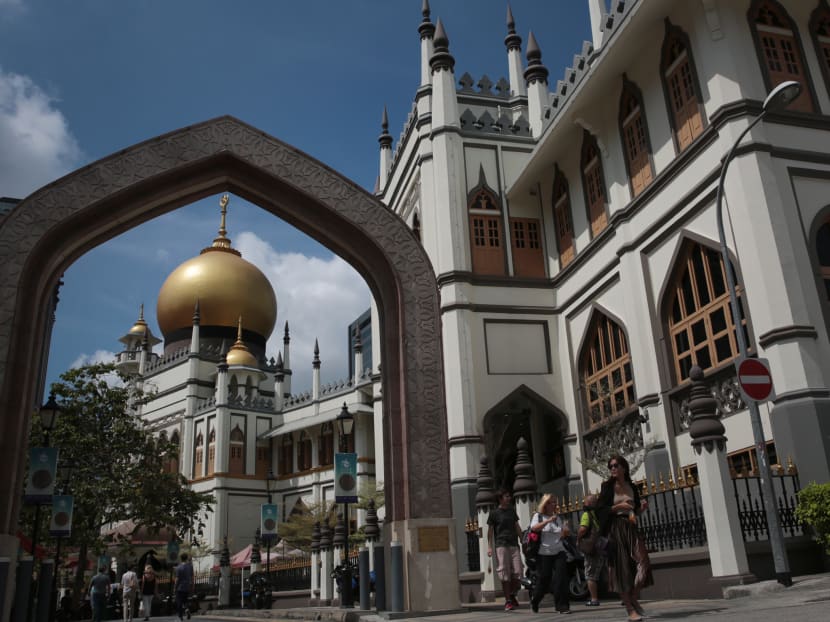S’pore Bicentennial in 2019 to recapture historic events from 720 years ago
SINGAPORE — As the country prepares to face future challenges, it is important for Singaporeans to grasp its history, which goes back to 1299 at the least, and to understand the struggles in the earlier years.

In the historic Kampong Glam district, Sultan Mosque — which was completed in 1826 with S$3,000 contributed by Sir Raffles — plans to hold a travelling roadshow to showcase its history, with support from the team behind the bicentennial. Photo: Jason Quah/TODAY
SINGAPORE — As the country prepares to face future challenges, it is important for Singaporeans to grasp its history, which goes back to 1299 at the least, and to understand the struggles in the earlier years.
This is what the Singapore Bicentennial in 2019 will aim to do: Offer a window into this past and what made modern Singapore possible, veteran historian Tan Tai Yong said at a press briefing last week.
Professor Tan is an advisory panel member for the anniversary event, which will mark 200 years since Sir Stamford Raffles arrived in Singapore in 1819.
Though it is billed as the "prequel" to Singapore's Golden Jubilee (SG50) in 2015 — meaning the events that paved the way for SG50 — the bicentennial will be on a "far smaller scale", Mr Gene Tan said. Mr Tan is the executive director of the Singapore Bicentennial Office, which was set up in the last quarter of this year, along with a 16-member advisory panel that includes Prof Tan, former senior parliamentary secretary Yatiman Yusof, film director Kelvin Tong and lawyer Sujatha Selvakumar.
Calling the bicentennial an "important milestone", Prime Minister Lee Hsien Loong noted in his New Year Message on Sunday (Dec 31) that Sir Raffles had launched Singapore on a different trajectory that paved the way for a free port and a modern city.
While progress was "not a straight line upwards" — there were dislocations and disruptions aplenty, including war and peace, and economic depression and prosperity — Singapore "ultimately ... came through and became an independent nation", said Mr Lee.
To gear up for the occasion, various communities from cultural and religious organisations and schools, for instance, will be engaged through the new year and 2019 to stitch together stories of shared history.
The public may get involved via these partner community organisations, which number more than 60. There will also be a range of activities planned, such as exhibitions at museums and cultural institutions.
Asked about the bicentennial’s expected cost, Mr Tan said it was unavailable right now, as the project is still being developed. It will support community partners in the areas of content and research, and possibly funding too, he added.
The bicentennial — overseen by Cabinet ministers Josephine Teo and Desmond Lee — will also figure in the country's line-up of yearly events, such as the National Day Parade.
Organisers planning the anniversary have given it the tagline "From Singapore to Singaporean", and will examine events from as far back as 1299, when Sang Nila Utama, the first leader of Singapore's earliest city, arrived. A maritime emporium based on regional trade later emerged.
They will also chart the country's past through to its independence, as it develops into a nation with a "Singaporean DNA".
Prof Tan, who is also president of the Yale-NUS College, said: "If we don't understand our history, we don't understand where we came from, we don't understand the kinds of challenges we faced (and) the choices we made, we're not going to be able to understand who we are as a people."
He added that this is important in educating "a country and its citizens".
Mr Tan stressed that the bicentennial is "not so much an occasion to celebrate". It is supposed to be a reflection of "how we came to be, how far we have come, and... what that means for our future (and) how we can go forward".
Prof Tan also said that it is not meant to be a "rose-tinted" account of events of the last two centuries, but rather a way to "capture the full essence and the full complexities of what happened".
The commemoration will look at all facets, including unpleasant events such as riots, squalor, and the 1915 mutiny by Sepoy mutineers, who were instigated by prisoners from the German warship SMS Emden that they were guarding.
COMMUNITY OUTREACH
At the grassroots level, community groups interviewed are looking to ride on the bicentennial to broaden the outreach of their activities.
For instance, the Eurasian Association, which is marking its 100th anniversary in 2019, will launch a revamped heritage centre and hold a festival which will delve into Eurasian culture, food, music and heritage, its president Benett Theseira said.
The Singapore Khalsa Association is working to boost the heritage element of its annual Vesakhi carnival, which marks the Sikh new year, to tie it to the bicentennial, president Mohinder Singh said.
The Singapore Federation of Chinese Clan Associations is exploring programmes such as exhibitions featuring unsung heroes among those who had been a part of Singapore's history.
In the historic Kampong Glam district, Sultan Mosque — which was completed in 1826 with S$3,000 contributed by Sir Raffles — plans to hold a travelling roadshow to showcase its history, with support from the team behind the bicentennial. Mr Mohamed Patail, chairman of the mosque's board of trustees, said that it is also exploring the possibility of distributing mementoes featuring the mosque to the public.
As a highlight of the year-long commemoration, Mr Tan said that a "multimedia" experience is in the works, though he declined to reveal more details for now. Mr Tan previously led the Singapore Memory Project that was part of SG50, where people's memories of Singapore were put together in print, audio and video. He was also in charge of the Future of Us exhibition for the jubilee celebrations, which presented Singaporeans' vision of what living here would be like in the year 2030.








